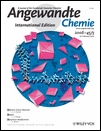The Fluorinase from Streptomyces cattleya Is Also a Chlorinase†
Hai Deng Dr.
School of Chemistry and Centre for Biomolecular Science, University of St Andrews, St Andrews, KY16 9ST, UK, Fax: (+44) 1334-463-808
Search for more papers by this authorSteven L. Cobb Dr.
School of Chemistry and Centre for Biomolecular Science, University of St Andrews, St Andrews, KY16 9ST, UK, Fax: (+44) 1334-463-808
Search for more papers by this authorAndrew R. McEwan
School of Chemistry and Centre for Biomolecular Science, University of St Andrews, St Andrews, KY16 9ST, UK, Fax: (+44) 1334-463-808
Search for more papers by this authorRyan P. McGlinchey
School of Chemistry and Centre for Biomolecular Science, University of St Andrews, St Andrews, KY16 9ST, UK, Fax: (+44) 1334-463-808
Search for more papers by this authorJames H. Naismith Prof. Dr.
School of Chemistry and Centre for Biomolecular Science, University of St Andrews, St Andrews, KY16 9ST, UK, Fax: (+44) 1334-463-808
Search for more papers by this authorDavid O'Hagan Prof. Dr.
School of Chemistry and Centre for Biomolecular Science, University of St Andrews, St Andrews, KY16 9ST, UK, Fax: (+44) 1334-463-808
Search for more papers by this authorDavid A. Robinson Dr.
School of Chemistry and Centre for Biomolecular Science, University of St Andrews, St Andrews, KY16 9ST, UK, Fax: (+44) 1334-463-808
Search for more papers by this authorJonathan B. Spencer Dr.
Chemistry Laboratories, University of Cambridge, Lensfield Rd, Cambridge, CB2 1EW, UK
Search for more papers by this authorHai Deng Dr.
School of Chemistry and Centre for Biomolecular Science, University of St Andrews, St Andrews, KY16 9ST, UK, Fax: (+44) 1334-463-808
Search for more papers by this authorSteven L. Cobb Dr.
School of Chemistry and Centre for Biomolecular Science, University of St Andrews, St Andrews, KY16 9ST, UK, Fax: (+44) 1334-463-808
Search for more papers by this authorAndrew R. McEwan
School of Chemistry and Centre for Biomolecular Science, University of St Andrews, St Andrews, KY16 9ST, UK, Fax: (+44) 1334-463-808
Search for more papers by this authorRyan P. McGlinchey
School of Chemistry and Centre for Biomolecular Science, University of St Andrews, St Andrews, KY16 9ST, UK, Fax: (+44) 1334-463-808
Search for more papers by this authorJames H. Naismith Prof. Dr.
School of Chemistry and Centre for Biomolecular Science, University of St Andrews, St Andrews, KY16 9ST, UK, Fax: (+44) 1334-463-808
Search for more papers by this authorDavid O'Hagan Prof. Dr.
School of Chemistry and Centre for Biomolecular Science, University of St Andrews, St Andrews, KY16 9ST, UK, Fax: (+44) 1334-463-808
Search for more papers by this authorDavid A. Robinson Dr.
School of Chemistry and Centre for Biomolecular Science, University of St Andrews, St Andrews, KY16 9ST, UK, Fax: (+44) 1334-463-808
Search for more papers by this authorJonathan B. Spencer Dr.
Chemistry Laboratories, University of Cambridge, Lensfield Rd, Cambridge, CB2 1EW, UK
Search for more papers by this authorWe thank the BBSRC for funding (H.D. and D.A.R.) and GSK and the Pro-Bio-Faraday for a Studentship (R.P.M.).
Graphical Abstract
Choices choices: The fluorinase enzyme from Streptomyces cattleya (catalyzes the formation of a CF bond from fluoride ions) also has the capacity to utilize a chloride ion although it has a clear preference for the fluoride ion. The enzyme mediates a nucleophilic chlorination reaction, which is an unusual mechanism for enzymatic chlorination.
Supporting Information
Supporting information for this article is available on the WWW under http://www.wiley-vch.de/contents/jc_2002/2006/z503582_s.pdf or from the author.
Please note: The publisher is not responsible for the content or functionality of any supporting information supplied by the authors. Any queries (other than missing content) should be directed to the corresponding author for the article.
References
- 1M. Sanada, T. Miyano, S. Iwadare, J. M. Williamson, B. H. Arison, J. L. Smith, A. W. Douglas, J. M. Liesch, E. Inamine, J. Antibiot. 1984, 39, 259–265.
- 2D. O'Hagan, D. B. Harper, Nat. Prod. Rep. 1994. 11, 123–133.
- 3D. O'Hagan, C. Schaffrath, S. Cobb, J. T. G. Hamilton, C. D. Murphy, Nature 2002, 416, 279.
- 4C. Schaffrath, H. Deng, D. O'Hagan, FEBS Lett. 2003, 547, 111–114.
- 5C. Schaffrath, S. L. Cobb, D. O'Hagan, Angew. Chem. 2002, 114, 4069–4071;
10.1002/1521-3757(20021018)114:20<4069::AID-ANGE4069>3.0.CO;2-W Google ScholarAngew. Chem. Int. Ed. 2002, 41, 3913–3915.10.1002/1521-3773(20021018)41:20<3913::AID-ANIE3913>3.0.CO;2-E CAS PubMed Web of Science® Google Scholar
- 6S. L. Cobb, H. Deng, J. T. G. Hamilton, R. P. McGlinchey, D. O'Hagan, Chem. Commun. 2004, 592–593.
- 7H. Deng, D. O'Hagan, C. Schaffrath, Nat. Prod. Rep. 2004, 21, 773–784.
- 8C. D. Murphy, S. J. Moss, D. O'Hagan, Appl. Environ. Microbiol. 2001, 67, 4919–4921.
- 9C. D. Murphy, D. O'Hagan, C. Schaffrath, Angew. Chem. 2001, 113, 4611–4613;
10.1002/1521-3757(20011203)113:23<4611::AID-ANGE4611>3.0.CO;2-U Google ScholarAngew. Chem. Int. Ed. 2001, 40, 4479–4481.10.1002/1521-3773(20011203)40:23<4479::AID-ANIE4479>3.0.CO;2-1 CAS PubMed Web of Science® Google Scholar
- 10C. J. Dong, F. L. Huang, H. Deng, C. Schaffrath, J. B. Spencer, D. O'Hagan, J. H. Naismith, Nature 2004, 427, 561–565.
- 11C. D. Cadicamo, J. Courtieu, H. Deng, A. Meddour, D. O'Hagan, ChemBioChem 2004, 5, 685–690.
- 12D. O'Hagan, R. J. M. Goss, A. Meddour, J. Courtieu, J. Am. Chem. Soc. 2003, 125, 379–387.
- 13H. Senn, D. O'Hagan, W. Thiel, J. Am. Chem. Soc. 2005, 127, 13643–13655.
- 14B. E. Smart, Properties of Fluorinated Organic Compounds, Vol. 1, ACS, 1995, pp. 979–1010.
- 15A. L. Margolin, D. R. Borcherding, D. Wolfkugel, N. Margolin, J. Org. Chem. 1994, 59, 7214–7218.
- 16S. L. Cobb, Ph.D thesis, University of St Andrews, 2005.
- 17A. Butler, J. N. Carter-Franklin, Nat. Prod. Rep. 2004, 21, 180–188.
- 18C. Dong, S. Flecks, S. Unversucht, C. Haupt, K.-H. van Pée, J. H. Naismith, Science 2005, 309, 2216–2219.
- 19F. H. Vaillancourt, E. Yeh, D. A. Vosburg, S. E. O'Connor, C. T. Walsh, Nature 2005, 436, 1191–1194.
- 20D. Saxena, S. Aouad, J. Attieh, H. Saini, Appl. Environ. Microbiol. 1998, 64, 2831–2835.
- 21X. Ni, L. P. Hager, Proc. Natl. Acad. Sci. USA 1999, 96, 3611–3615.





